Using Lirc to Read Ir Codes Raspberry Pi
Objective
In this project, we will connect an Infrared remote command receiver to Raspberry Pi. Later on an IR remote controller central is pushed, Raspberry Pi will decode the signal and display the cardinal code on the terminal.
This project used a IR receiver library called LIRC. We also have a simple programming tutorial which does not require LIRC library. Hither is the link: https://osoyoo.com/2021/05/26/use-basic-gpio-library-to-get-ir-remote-code-no-need-lirc/
Parts:
| one pc | Raspberry Pi 2/3/nil 10 1 |  |
| 1 pc | 8GB MicroSD memory carte x 1preinstalled Raspbian Os. | 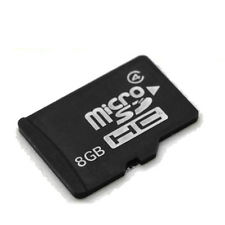 |
| 1 pc | VS1838B x 1 |  |
| i pc | Infrared Remote Controller 10 1 |  |
| 1 pc | breadboard x 1 | 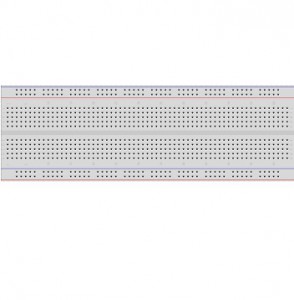 |
| 1 pc | GPIO breakout kit(optional) |  |
| some | Jumper Wires |  |
Circuit Connection Graph

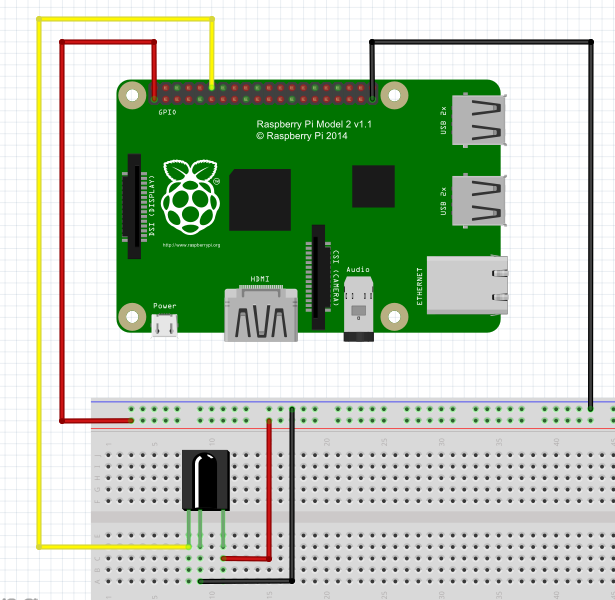
Install lirc library
LIRC (Linux Infrared remote control)is an open source library which permit linux to decode IR indicate
sudo apt-get install lirc
change configuration with nano command
sudo nano /etc/lirc/hardware.conf
meliorate post-obit contents in /etc/lirc/hardware.conf file
LIRCD_ATGS=""
Driver="default"
DEVICE="/dev/lirc0"
MODULES="lirc-rpi
Edit module file with nano
sudo nano /etc/modules
add post-obit ii lines in the end of /etc/modules添加完两行后按ctrl+o 保存修改,按ctrl+x退出
lirc-dev
lirc-rpi gpio_in_pin_eighteen gpio_out_pin_17
GPIO 18 pivot will get input data from IR receiver
Raspberry Pi GPIO pin graph:
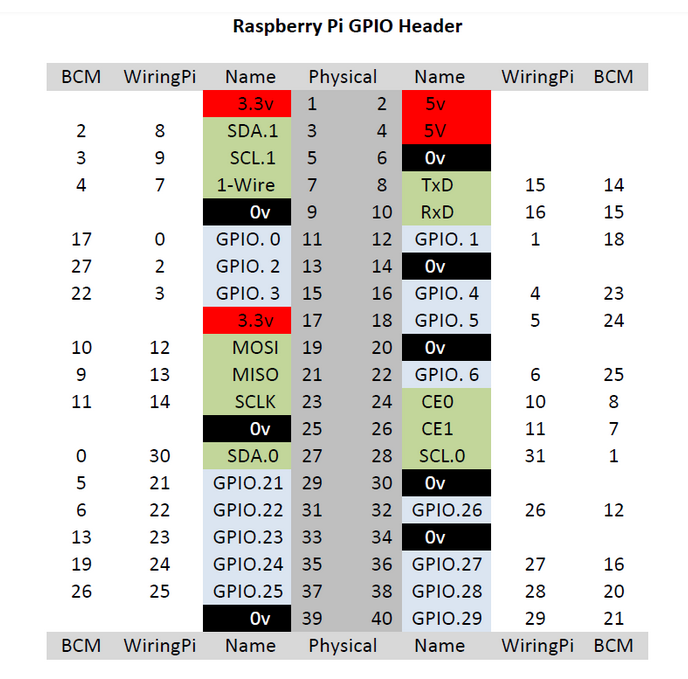
Restart the raspberry pi to enable configuration:
reboot
restart lirc by running followingcommand
sudo /etc/init.d/lirc restart
Exam IR receiver
one)Stop lirc by running:
sudo /etc/init.d/lirc finish
2)run following code
mode2 –d /dev/lirc0
After running in a higher place control, terminal might show following errors:
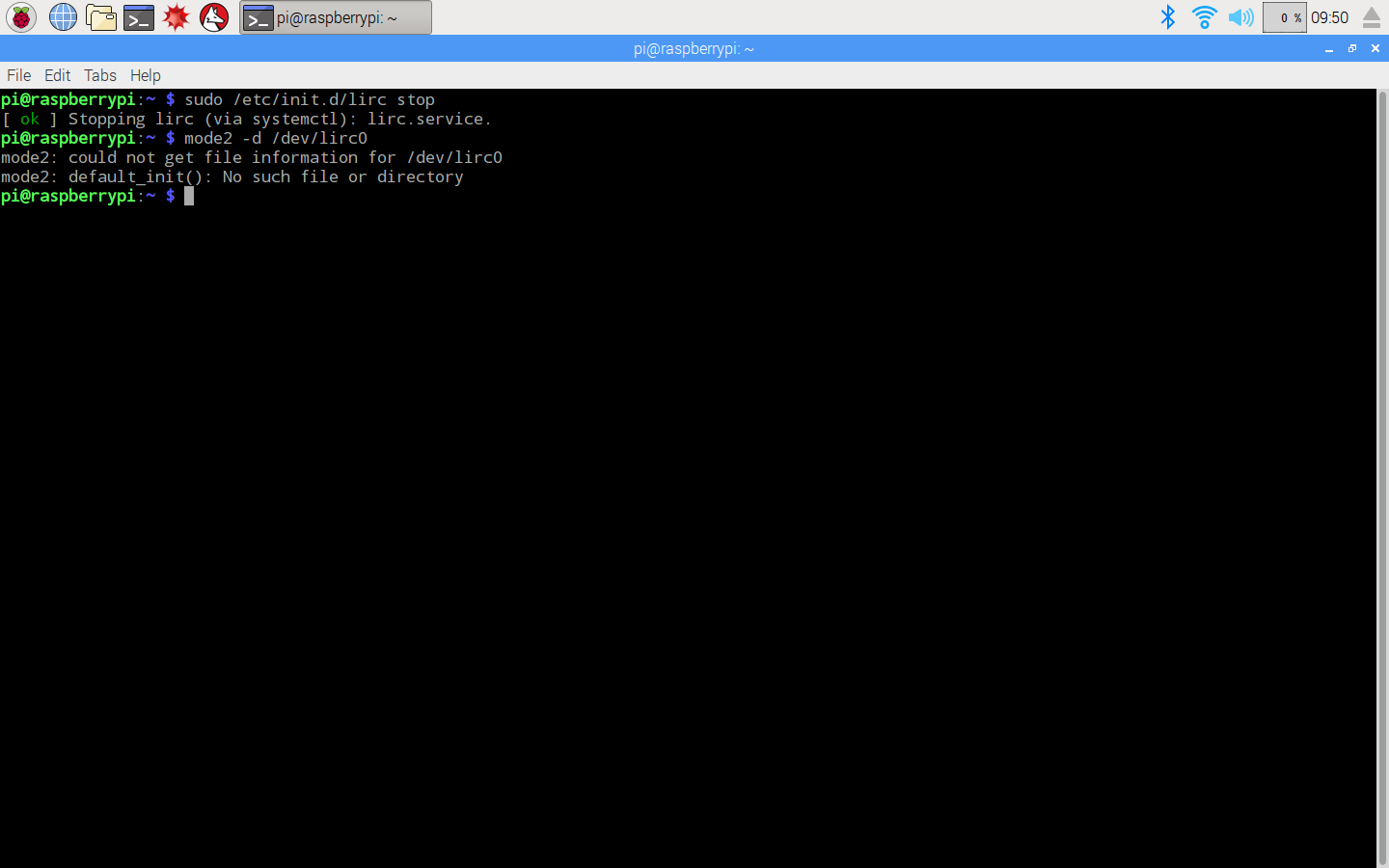
This ways /lirco module has non be installed under /dev diretory .
To fix it, y'all need uncomment "#dtoverlay=lirc-rpi" in /boot/config.txt file
sudo nano /kicking/config.txt
find #dtoverlay=lirc-rpi and remove the "#" sign, printing ctrl-x to save and exit.
Reboot and test once again with following two commands:
reboot
mode2 -d /dev/lirc0
If no error shows up after running higher up commands, yous can press keys in the IR remoter control. You will come across following effect:

press ctrl-c to go out
Record IR code by running post-obit ii commands:
sudo /etc/init.d/lirc stop
irrecord –list–namespace
write down the key names every bit following:
KEY_CHANNELDOWN
KEY_CHANNELUP
KEY_CHANNEL
KEY_PREVIOUS
KEY_NEXT KEY_PLAY
KEY_VOLUMEDOWN
KEY_VOLUMEUP
KEY_EQUAL
KEY_NUMERIC_0 ~ KEY_NUMERIC_9
Run IR lawmaking record control:
irrecord -d /dev/lirc0 ~/lircd.conf
go on press Render key until yous see "Press Render now to start recording.".
Printing RETURN AGAIN ,then press each cardinal quickly as per the education in the screen. Each press will evidence upward a dot sign in the screen. Afterward the dots fill 2 lines, screen will prompt: "Please enter the name for the adjacent push button (press to finish recording)", then press the key you want to record..
Case : enter KEY_PLAY and return, screen prompt "Now hold down button "KEY_PLAY", press and hold PLAY key in your IR controller, PI will record the key code and prompt "Please enter the name for the adjacent push (press to stop recording)"… repeat the procedure until all your keys are recorded, save the config file to lircd.conf
Finally replace /etc/lirc/lircd.conf file with your lircd.conf file :
sudo cp ~/lircd.conf /etc /lirc/lircd.conf
restart lirc and test IR keys with following 2 commands:
sudo /etc/init.d/lirc get-go
irw
Afterwards you printing keys in the IR controller, Pi will display key codes equally following:
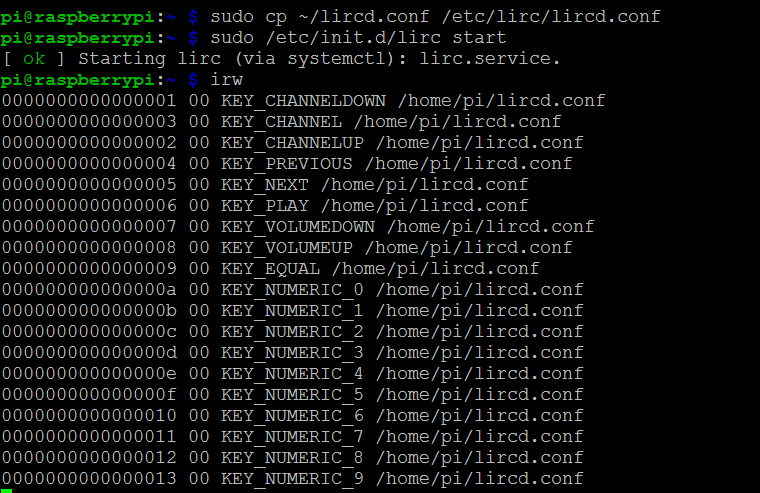
You lot might feel that LIRC library installation and configuration is a footling bit complicated. If you don't want to use LIRC library, nosotros have another simple solution to program IR receiver with basic GPIO functions. Here is the link: https://osoyoo.com/2021/05/26/utilise-basic-gpio-library-to-go-ir-remote-code-no-need-lirc/
Source: https://osoyoo.com/2016/12/15/raspberrypi-ir-remote/
0 Response to "Using Lirc to Read Ir Codes Raspberry Pi"
Post a Comment